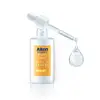What's inside
What's inside
 Key Ingredients
Key Ingredients

 Benefits
Benefits

 Concerns
Concerns

 Ingredients Side-by-side
Ingredients Side-by-side

Water
Skin ConditioningMandelic Acid
AntimicrobialMethylpropanediol
SolventAminomethyl Propanol
BufferingSodium Hyaluronate
HumectantXanthan Gum
EmulsifyingDisodium EDTA
Citric Acid
BufferingLactic Acid
BufferingAscorbyl Glucoside
AntioxidantPEG-40 Hydrogenated Castor Oil
EmulsifyingPolysorbate 20
EmulsifyingMelaleuca Alternifolia Leaf Oil
AntioxidantSalicylic Acid
MaskingPhenoxyethanol
PreservativeSodium Metabisulfite
AntioxidantWater
Skin ConditioningGlycerin
HumectantAlcohol
AntimicrobialDipropylene Glycol
HumectantButylene Glycol
HumectantPEG/PPG/Polybutylene Glycol-8/5/3 Glycerin
HumectantNiacinamide
SmoothingHydroxyethylpiperazine Ethane Sulfonic Acid
BufferingBis-PEG-18 Methyl Ether Dimethyl Silane
Emollient3-O-Ethyl Ascorbic Acid
Skin ConditioningIsononyl Isononanoate
EmollientBHT
AntioxidantLinalool
PerfumingGeraniol
PerfumingParfum
MaskingSalicylic Acid
MaskingSodium Citrate
BufferingSodium Hyaluronate
HumectantPhenoxyethanol
PreservativePhenylethyl Resorcinol
AntioxidantAdenosine
Skin ConditioningAmmonium Polyacryloyldimethyl Taurate
Emulsion StabilisingTocopheryl Acetate
AntioxidantDisodium EDTA
Limonene
PerfumingHydrogenated Lecithin
EmulsifyingCitric Acid
BufferingCitrus Limon Fruit Extract
MaskingCitrus Junos Fruit Extract
Skin ConditioningXanthan Gum
EmulsifyingMaltodextrin
AbsorbentAcetyl Trifluoromethylphenyl Valylglycine
Skin ConditioningOxothiazolidinecarboxylic Acid
Skin ConditioningBenzyl Salicylate
PerfumingBenzyl Alcohol
PerfumingWater, Glycerin, Alcohol, Dipropylene Glycol, Butylene Glycol, PEG/PPG/Polybutylene Glycol-8/5/3 Glycerin, Niacinamide, Hydroxyethylpiperazine Ethane Sulfonic Acid, Bis-PEG-18 Methyl Ether Dimethyl Silane, 3-O-Ethyl Ascorbic Acid, Isononyl Isononanoate, BHT, Linalool, Geraniol, Parfum, Salicylic Acid, Sodium Citrate, Sodium Hyaluronate, Phenoxyethanol, Phenylethyl Resorcinol, Adenosine, Ammonium Polyacryloyldimethyl Taurate, Tocopheryl Acetate, Disodium EDTA, Limonene, Hydrogenated Lecithin, Citric Acid, Citrus Limon Fruit Extract, Citrus Junos Fruit Extract, Xanthan Gum, Maltodextrin, Acetyl Trifluoromethylphenyl Valylglycine, Oxothiazolidinecarboxylic Acid, Benzyl Salicylate, Benzyl Alcohol
 Reviews
Reviews

Ingredients Explained
These ingredients are found in both products.
Ingredients higher up in an ingredient list are typically present in a larger amount.
Citric Acid is an alpha hydroxy acid (AHA) naturally found in citrus fruits like oranges, lemons, and limes.
Like other AHAs, citric acid can exfoliate skin by breaking down the bonds that hold dead skin cells together. This helps reveal smoother and brighter skin underneath.
However, this exfoliating effect only happens at high concentrations (20%) which can be hard to find in cosmetic products.
Due to this, citric acid is usually included in small amounts as a pH adjuster. This helps keep products slightly more acidic and compatible with skin's natural pH.
In skincare formulas, citric acid can:
While it can provide some skin benefits, research shows lactic acid and glycolic acid are generally more effective and less irritating exfoliants.
Most citric acid used in skincare today is made by fermenting sugars (usually from molasses). This synthetic version is identical to the natural citrus form but easier to stabilize and use in formulations.
Read more about some other popular AHA's here:
Learn more about Citric AcidDisodium EDTA plays a role in making products more stable by aiding other preservatives.
It is a chelating agent, meaning it neutralizes metal ions that may be found in a product.
Disodium EDTA is a salt of edetic acid and is found to be safe in cosmetic ingredients.
Learn more about Disodium EDTAPhenoxyethanol is a preservative that has germicide, antimicrobial, and aromatic properties. Studies show that phenoxyethanol can prevent microbial growth. By itself, it has a scent that is similar to that of a rose.
It's often used in formulations along with Caprylyl Glycol to preserve the shelf life of products.
Salicylic Acid (also known as beta hydroxy acid or BHA) is a well-known ingredient for treating skin that struggles with acne and clogged pores. It exfoliates both the skin's surface and deep within the pores to help clear out buildup, control oil, and reduce inflammation.
Unlike AHAs (alpha hydroxy acids), salicylic acid is oil-soluble. This allows it to penetrate into pores which makes it especially effective for treating blackheads and preventing future breakouts.
Salicylic acid is also known for its soothing properties. It has a similar structure to aspirin and can calm inflamed or irritated skin, making it a good option for acne-prone skin that is also sensitive.
Concentrations of 0.5-2% are recognized by the U.S. FDA as an over-the-counter topical acne product.
It can cause irritation and/or dryness if one's skin already has a compromised moisture barrier, so it's best to focus on repairing that before introducing this ingredient into your routine.
While salicylic acid does not increase sun sensitivity, it’s still important to wear sunscreen daily to protect your skin.
If you are looking for the ingredient called BHA or Butylated Hydroxyanisole, click here.
Learn more about Salicylic AcidSodium Hyaluronate is hyaluronic acid's salt form. It is commonly derived from the sodium salt of hyaluronic acid.
Like hyaluronic acid, it is great at holding water and acts as a humectant. This makes it a great skin hydrating ingredient.
Sodium Hyaluronate is naturally occurring in our bodies and is mostly found in eye fluid and joints.
These are some other common types of Hyaluronic Acid:
Learn more about Sodium HyaluronateWater. It's the most common cosmetic ingredient of all. You'll usually see it at the top of ingredient lists, meaning that it makes up the largest part of the product.
So why is it so popular? Water most often acts as a solvent - this means that it helps dissolve other ingredients into the formulation.
You'll also recognize water as that liquid we all need to stay alive. If you see this, drink a glass of water. Stay hydrated!
Learn more about WaterXanthan gum is used as a stabilizer and thickener within cosmetic products. It helps give products a sticky, thick feeling - preventing them from being too runny.
On the technical side of things, xanthan gum is a polysaccharide - a combination consisting of multiple sugar molecules bonded together.
Xanthan gum is a pretty common and great ingredient. It is a natural, non-toxic, non-irritating ingredient that is also commonly used in food products.
Learn more about Xanthan Gum